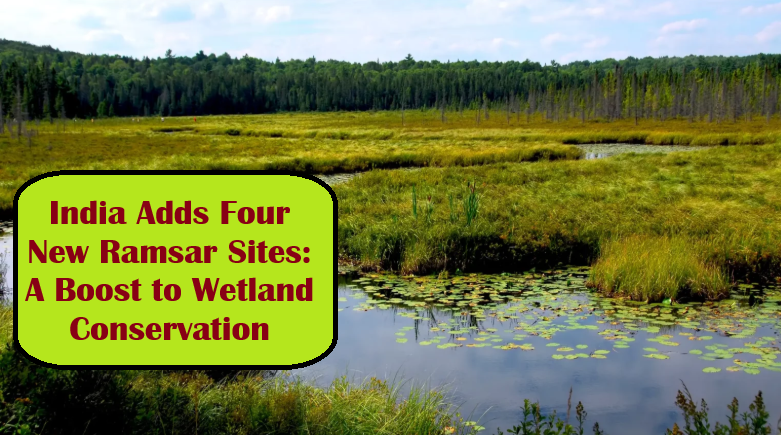
06-Jun-2025 12:00 PM
🌿 India Adds Four New Ramsar Sites: A Boost to Wetland Conservation
India has taken another proud stride in wetland preservation by adding four new Ramsar sites, bringing the national total to 89 wetlands of international importance. This is not just a number—it’s a commitment to conserving our vital ecosystems and biodiversity. Among the additions, Tamil Nadu shines again by reaching 20 Ramsar sites, while Sikkim and Jharkhand make history by entering the list for the first time.
Let’s understand what makes each of these wetlands special.
🐦 1. Therthangal Bird Sanctuary, Tamil Nadu
Declared in: 2010
Area: 29.29 hectares
This compact yet rich sanctuary in Tamil Nadu is a haven for bird lovers, especially during the migratory season from October to March. It features a variety of native flora such as Aponogeton nutans, Hydrilla, and Tamarindus indica.
The sanctuary plays a critical role in preserving avian species and maintaining ecological balance.
🦜 2. Sakkarakottai Bird Sanctuary, Tamil Nadu
Declared in: 2012
Area: 230.49 hectares
Spread across a vast area, this sanctuary is a vibrant wetland ecosystem that houses species like the Lion-tailed Macaque and Giant Squirrel, apart from several migratory birds.
The local vegetation includes Neem, Palmyra Palm, and Gloriosa superba, all of which support the food web and nesting habitats.
🏞️ 3. Khecheopalri Wetland, Sikkim
Local Name: Sho Dzo Sho ("Oh Lady, Sit Here")
A site of deep spiritual and ecological value, this wetland is revered by both Hindus and Buddhists.
A unique feature: Birds actively prevent leaves from floating on the lake by picking them up, adding a magical touch to its ecological lore.
It is part of the Demazong Valley and is critical to ecotourism and biodiversity conservation in Sikkim.
🌊 4. Udhwa Lake, Jharkhand
Components: Pataura Jheel (155 ha) and Brahma Jamalpur Jheel (410 ha)
This bird sanctuary was declared in 1991 and is a vital wintering site for migratory birds arriving from as early as September.
Its proximity to a Ganga stream elevates both its scenic beauty and ecological importance.
Udhwa Lake serves as a nesting, roosting, and feeding ground for a wide variety of birds, both native and migratory.
🌍 Why It Matters
Wetlands are crucial to our planet—they filter water, mitigate floods, store carbon, and provide habitats for thousands of species.
With climate change and urban development threatening natural habitats, each Ramsar designation signals global recognition and conservation priority.
📘 MCQs for UPSC & Other Exams
Q1. Which of the following states added its first Ramsar site in 2025?
A) Odisha
B) Sikkim
C) Karnataka
D) Rajasthan
✅ Answer: B) Sikkim
Q2. Which Ramsar site is known for the belief that birds prevent leaves from floating on the lake?
A) Udhwa Lake
B) Sakkarakottai Sanctuary
C) Khecheopalri Wetland
D) Chilika Lake
✅ Answer: C) Khecheopalri Wetland
Q3. Therthangal Bird Sanctuary is located in which state?
A) Kerala
B) Tamil Nadu
C) Andhra Pradesh
D) Gujarat
✅ Answer: B) Tamil Nadu
Q4. Udhwa Lake is made up of how many major water bodies?
A) One
B) Two
C) Three
D) Four
✅ Answer: B) Two
📝 Conclusion: A Step in the Right Direction
These four new Ramsar sites reflect India’s growing awareness and commitment to environmental protection. As wetlands face increasing stress from urban expansion and pollution, global recognition can catalyze conservation efforts and attract attention, funding, and sustainable ecotourism.
It’s not just about saving birds and water—it’s about preserving life itself.